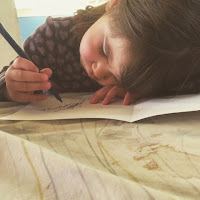Me - In the desert, there is a special plant that grows. It's unlike other plants. Do you know what a desert is?
AS - There's sand in a desert
LC - And it's hot.
DA - Yeah! Really hot
Me - You got it! The desert has very little water. This means it also has different plants from what we usually see. There is one plant called a Tumbleweed.
E - I go to Tumbleweeds!
Me - You know that word! We all do, because that is the name of our school. It is also the name of a plant. It's very special. Here is what it looks like:
Everyone looked very closely at this picture.
Me - Tumbleweeds grow up from the ground and into a ball shape. It's like any other plant. It has stems, leaves, flowers and seeds. What makes this plant unique is how it releases its seeds. The entire plant dries up and becomes very light. Then, when the seeds are ready, the stem breaks off at the first strong wind. The tumbleweed tumbles across the desert, or road, or field, or anywhere really. As it tumbles the seeds fall out!
We flip through a few more pictures of tumbleweeds growing singularly, together, rolling down roads, through cities, and in various different places.
Me - What I love about tumbleweeds is that they roll and tumble around. It seems like it would be fun to be a tumbleweed. I wonder how it might feel to be a tumbleweed. Does anyone have an idea?
AS - Maybe like this!
Soon, all of the children are rolling across the floor like tumbleweeds, sometimes crashing, mostly laughing with the joy that a tumbleweed must feel as it spreads its seeds across the land.


The tumbleweed gathering and story soon turned into somersaults and other stretching games, which fully supported the needs of these children in the moment. The goal of our small group moments is to introduce a new concept, then offer it as an invitation to the children to explore. I look forward to seeing how tumbleweeds will begin to integrate themselves into our daily play!

















































